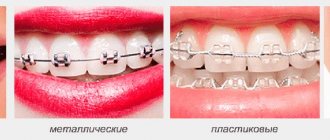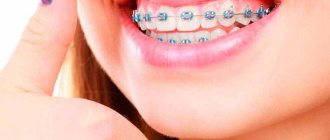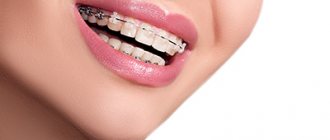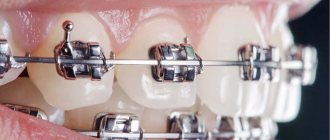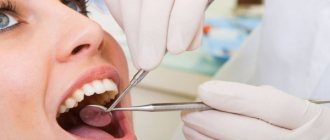Preparing for positioning
Fixing braces requires preparation. First, the patient will have an initial consultation with an orthodontist. After this, the dentist will prepare the oral cavity for attaching corrective structures.
Installation of braces is allowed only on healthy elements of the jaw arch. Preparation consists of several stages:
- Treatment of caries. It is necessary to detect carious lesions, even the smallest ones, and eliminate them.
- Checking installed seals. If your teeth were filled a long time ago, you need to check the strength of the old linings. If necessary, replace with new ones.
- Treatment of periodontal disease. The oral mucosa must be absolutely healthy. Therefore, even minor inflammatory processes can worsen after the installation of braces. We need to eliminate them.
- Remineralization. If the enamel on the teeth is thinned, the units are sensitive or there are cracks on them, it is necessary to carry out remineralization and strengthen the enamel.
Preparation for attaching braces, depending on the condition of the oral cavity, can last up to several months. During orthodontic therapy, it is necessary to take panoramic photographs of the dental system. Using them, the dentist will draw up a treatment plan and determine where to fix the locks. Before carrying out the bonding procedure, you need to make an appointment for professional teeth cleaning. The purpose of this dental service is to remove tartar and plaque. The braces should be fixed to a clean surface of the teeth. During fastening, nothing should interfere with gluing the structure.
Price issue
In many dental clinics, the cost for installing braces is highlighted as a separate line.
But there are also clinics where the amount for fixing the orthodontic system is included in the total cost of manufacturing the system. On average, this service is estimated at approximately 30% of the total cost of the braces system.
The installation price for products made from different materials will vary. The more expensive the system itself, the more expensive it will cost to install.
| Product material | Direct installation amount, rub. |
| Metal | From 10 000 |
| Ceramics | From 18000 |
| Sapphire | From 25000 |
The direct method is the most common installation method. The indirect method is currently used in a limited number of clinics. This is explained by its novelty and limited experience of specialists.
Due to the need to make a plaster model and special trays with the indirect method, its cost will increase by approximately 6-9 thousand rubles, compared to the direct method for each type of product material.
Direct technology for fixing braces
This method of attaching a corrective structure involves attaching it specifically to each tooth. The doctor installs a dilator into the patient’s oral cavity that holds the cheeks, lips, and tongue. Thus, it isolates the dental units from the soft tissues. Each tooth is cleaned with dental paste and a brush. Then, one by one, the doctor applies a special composition containing phosphoric acid. The product is harmless, does not damage the enamel, and creates microscopic roughness, which is necessary for reliable fixation of braces. Next, the orthodontist applies an adhesive bond system to the teeth, and a composite material to the brackets. Then he presses the bracket onto the tooth and the assistant uses a lamp to illuminate the composite.
Among the advantages of the method, it is worth noting the possibility of correcting structures. The downside is that such fastening is labor-intensive, since the procedure lasts approximately an hour and a half. It is uncomfortable for the patient to keep his mouth open for such a long time. The doctor will have to perform a large amount of work in one visit.
Useful tips
Correcting a bite with braces can take a long period of time. The speed and result of correction of defects depends on how accurately the patient follows all the doctor’s recommendations.
For the first time after fixing the orthodontic system, the patient should avoid solid foods and increased load on the jaws. Preference should be given to soft or liquid foods.
In the future, you must follow these recommendations:
- Visit your doctor regularly. This is necessary to assess the condition, adjust the pressure on the teeth, change ligatures and make the necessary adjustments;
- Careful oral hygiene. It is necessary to brush your teeth several times a day, after eating food. If there are no conditions to brush your teeth, you must rinse your mouth thoroughly;
- Use additional hygiene products (irrigator, floss, brush, etc.);
- Adhere to a special diet. The patient should exclude foods that are too hard, sticky or tough from the diet;
- Carry out periodic professional teeth cleaning;
- Eliminate bad habits.
Following these recommendations will help speed up the treatment process and will also reduce the likelihood of parts of the system coming off or being damaged.
Indirect technology for fixing bracket systems
This method differs from the previous one in that there is practically no need for the presence of the patient, which is very convenient for him. The procedure for fixing braces consists of the following steps:
- The orthodontist takes an impression, takes it to a dental technician in the laboratory, who makes an exact copy of the patient’s jaw - a plaster model, and covers it with an insulating varnish coating.
- For each tooth, the dentist attaches a bracket to a false tooth specifically in the position that is optimal for the patient. At the same time, the doctor can work as long as he needs, which allows him to attach dental structures to correct the dentition in a mode convenient for him.
- The doctor applies liquid hardening silicone to the bracket system, which is converted into a mouth guard. The braces and mouth guard are placed in water for 30 minutes, the varnish dissolves and the braces remain in the mouth guard.
The patient comes to see the dentist and he transfers the finished mouthguard into the oral cavity. Lighting and installation of braces is carried out in the required place.
One of the advantages of this method is the quick installation of braces. It will take no more than an hour to fix. There are also disadvantages, but few people pay attention to them, since the result is excellent. It takes time to make the model, mouthguard and system, this is the only drawback.
Indirect installation
Recently, the indirect method of fixing braces has become popular. This method allows you to glue products to all teeth at the same time using a special tray.
The indirect method of fixing braces reduces the time of direct installation, but requires longer preliminary preparation in the laboratory.
What is the preparation:
- Impressions are taken of the patient's jaws , on the basis of which an accurate plaster model is made;
- The location of the locks is marked on the model using reference lines;
- Using burnt sugar or heating the model, the clasps are fixed to the jaw model;
- A special mouthguard is made that accurately follows the contours of the teeth;
- The mouth guard is pressed against the model , thereby transferring the locks onto it.
Installation of the structure to the patient is carried out as follows:
- A retractor is installed;
- Tooth enamel is etched with an orthophosphorus compound;
- After 30 seconds, the solution is washed off;
- The surface of the teeth is dried;
- A protective composite is applied;
- An adhesive is applied to the back of the locks;
- A mouthguard with braces is placed on the jaw;
- After an hour, the mouth guard is removed;
- A metal arc and ligatures are installed.
Among the advantages of this method are:
- Quick installation due to simultaneous gluing to all teeth;
- Comfort for the patient;
- Precision installation helps to avoid unnecessary pain and speeds up the treatment process.
The disadvantages are:
- It is difficult to determine the correct installation point;
- Inability to control the process of fixation on each tooth;
- It is difficult to remove excess glue;
- Long preparation process.
Watch the video to see how braces are installed indirectly.
Resilines fastening system
Fixing Resilines braces is another modern method practiced in dentistry. This is the most popular adhesive for attaching braces. Its adhesive properties are very soft and sticky, ideal for bonding any type of overbite correction. Using the composition it is possible to fix metal, sapphire and ceramic products. The adhesive quickly hardens under the influence of ultraviolet lamps. But until the braces are glued and the locks are installed, it remains soft. The metal arch can be installed immediately after attaching the locks.
Regardless of the chosen method, the orthodontist, first of all, needs to focus not on the method of fixation and type of brace system, but on the doctor’s expertise. With the right approach, any of the methods will be effective.
Methods of installation and fastening of structures
After the end of the preparatory period, the doctor decides on the format of the main stage of work. Dentists distinguish between two installation methods: direct and indirect.
- Direct installation method
Choosing this method involves manually fixing the locks to each tooth. Such work requires not only a lot of patience and time, but also the experience of an orthodontist. Since teeth have different shapes and sizes, the fasteners must be fixed in the correct location on the surface of the tooth enamel.
The work algorithm is as follows:
- Installation of the retractor.
- To improve adhesion, a special composition is applied to the tooth surface. Phosphoric acid roughens the enamel, which helps fix the clasps more securely on the tooth surface.
- After 25-30 seconds, the solution is washed off, the surface can be dried with a stream of warm air.
- To form protection, a composite is applied to the enamel.
- The ingredients to prepare the glue are mixed.
- The composition is applied to the inside of the clasps.
- The clasps are alternately fixed on the teeth.
- Remains of glue protruding from under the clasps are carefully removed.
- After checking the reliability of gluing, a metal arc of the required rigidity and ligature is inserted into the locks.
The glue hardens in about a day, and the installation procedure takes about 1.5 hours. On the first day, patients are recommended to take exclusively liquid and soft foods.
Advantages and disadvantages
The advantages include:
- reliability of fixation;
- impossibility of food getting into the space between the tooth and the clasp;
- possibility of adjustments during installation;
- fastening accuracy.
Dentists consider the painstaking and lengthy work to be a disadvantage. In addition, the patient is required to sit motionless in the chair the entire time the dentist is working.
- Indirect installation method
This method is faster, since the clasps of the braces are fixed together using a special mouthguard. Indirect installation takes less time in the dentist's office, but requires longer fabrication in a laboratory setting.
Preparing to install the system includes several steps:
- Taking impressions.
- Making a plaster model.
- Marking on the plaster model of the jaw where the clasps are attached.
- Making a custom mouthguard.
- Trying on locks on a model.
The installation process in the oral cavity is almost identical to the direct method, with the only difference: the dentist does not glue the clasps manually, but attaches them to the surface of the units with one push of the mouthguard.
Pros and cons of the technique
Among the advantages, doctors note the speed of installation and patient comfort during the procedure.
The disadvantages include the difficulty of controlling each individual clasp, the lengthy preparation process and the difficulty of removing residual adhesive composition.
- Pitts system
The installation methods indicated are the experience of dentists. However, in addition to experience, there is a protocol for the correct selection and fixation of orthodontic structures.
Using measurements of the length of the tooth crown and comparing the obtained data according to the Pitts table helps dentists avoid possible mistakes when selecting a system for correcting dental pathologies.
The installation point of the bracket bracket is calculated as follows:
- Unit crown length measurement.
- Search for the result obtained in the GPS-A column.
- The installation height is visible in the cross line.
Upper jaw
| GPS-A | 1 | 2 | 3 | 4 | 5 | 6 | 7 |
| 8 | 4 | 4 | 4,5 | 4,5 | 4 | 3 | 3 |
| 9 | 4,5 | 4,5 | 5 | 5 | 4,5 | 3,5 | 3,5 |
| 10 | 5 | 5 | 5,5 | 5,5 | 5 | 4 | 4 |
| 11 | 5 | 5 | 6 | 6 | 5,5 | 4,5 | 4,5 |
Lower jaw
| GPS-A | 1 | 2 | 3 | 4 | 5 | 6 | 7 |
| 9 | 5 | 4,5 | 4,5 | 4 | 3,5 | 2,5 | 2 |
| 10 | 5,5 | 5 | 5 | 4,5 | 4 | 3 | 2 |
| 11 | 6,5 | 5,5 | 5,5 | 5 | 4,5 | 3,5 | 2,5 |
| 12 | 7 | 6 | 6 | 5 | 5,5 | 4 | 2,5 |
- Resilience
This system is the most common model of adhesive composition among doctors. Its adhesiveness gently and easily bonds the surface of the lock and tooth. Suitable for all types of bracket systems.
The product hardens under the light flux. Until light hits the glue, it remains quite pliable and soft, which allows you to adjust the location of the lock.
The set includes:
- syringe with glue;
- primer;
- syringe with enamel surface etching agent;
- holder and palette for mixing components;
- brush, attachments for it and syringes.
Table recommended for use when placing brackets vertically
Rationale
The data in the table presented (Tables 3 and 4) are based on a large number of clinical studies and measurements made on plaster casts and digital models obtained from patients treated by the teams of Dr. Tom Pitts and Thomas Castellanos. Its versatility and effectiveness will be the subject of other articles that review cases of successful treatment of patients using this table.
The table facilitates the vertical placement of brackets into positions that provide the correct smile arc as well as mutually protected occlusions.
The concept takes into account such a morphological characteristic of the occlusion as the articular process, which has a more elongated shape in individuals with a dolichocephalic type of skull than in patients with a mesocephalic or brachycephalic type. In persons with a dolichocephalic type of skull, compared to patients with a brachycephalic type, the tubercles of the large molars are higher and the fossae are deeper; clinical crowns of the anterior teeth are longer in the direction of the incisors. All these characteristics indicate that patients with a dolichocephalic skull type require a deeper vertical overlap for disocclusion of the lateral teeth. On the other hand, patients with a less elongated face type with a flatter temporomandibular joint projection and anterior teeth with shorter clinical crowns require less deep vertical overlap to disocclude the posterior teeth4.
Also, when considering the relationship of the incisors and the smile arc in the presence of a flat smile, clinicians should extrude the upper incisors or preserve the incisal smile arch in cases where this is esthetically appropriate.
To obtain a functionally correct bite and a beautiful smile line, the difference in height between the occlusal-gingival position of the fossa with the occlusal cusps or incisor edges, measured in mm, must be maintained from the tube of the second molar up to the upper central incisor.
This discrepancy is also important when considering that the difference in millimeters between the height of the central incisor fossa and the height in millimeters from the second molar tube provides a basis for predicting how deep a vertical overlap will be obtained at the end of treatment. It also affects the amount of inclination of the occlusal plane.
The final vertical overlap of any deep or open bite also depends on elastics, disarticulation buttons, miniscrews and other additional elements that enhance the torque of the brackets. Of course, miniscrews can also help correct the position of the maxillary incisors by intruding the mandibular incisors if necessary.
The transition point between the anterior and lateral segments of the jaws additionally sets the line of the smile arc and therefore this point should be taken into account as a key point when planning the location of the entire dentition.
By further extruding the maxillary incisors to improve the smile arch and enamel display, a deeper bite can be achieved by increasing the vertical overlap. To avoid this effect, the table shows the compensation values for the position of the fossa in the section of braces from canine to canine of the lower jaw.
Instructions for using the table (Tables 3 and 4)
Before using the tables directly, some patients require recontouring of the dentition in order to obtain the ideal initial morphological properties of each tooth. This ameloplastic procedure is based on the study of plaster casts and involves the removal of only the necessary minimum of tooth enamel.
Ameloplasty covers the correction of pronounced marginal ridges on lingual surfaces, incisal angles and incisal ridges, as well as abnormal buccal surfaces. Abnormal buccal surfaces of teeth interfere with optimal placement of brackets that control rotation and torque1.
In most cases, recontouring of the canines is necessary to improve the position of the canines in the smile arch. This process does not affect their functional role in canine disocclusion.
The gum margins play a very important role in shaping the aesthetic appearance of the front teeth. Sometimes clinicians have to perform gingivoplasty using a laser, electrosurgery or any other similar method.
Ensuring that the morphology is correct is important, but clinicians should not recontour all hard and soft tissues because the presence of small discrepancies towards the end of treatment, when the teeth are in the best position possible, will allow for definitive correction.
Hygienic care
The bracket design has many areas that are very difficult to clean from food debris and plaque. Therefore, hygienic care for them requires special attention and patience. Special devices are used for cleaning (in addition to a regular toothbrush and paste):
- V-shaped brushes;
- brushes of different sizes and bristle angles;
- dental floss (floss);
- irrigator is a device for cleaning hard-to-reach places between teeth and orthodontic elements. The principle of operation is based on the controlled supply of a stream of water (or solution) under pressure.
You should clean your mouth while wearing braces twice a day. Ideally, after every meal. But, if this is not possible, then you need to rinse your mouth thoroughly after eating.
A little anatomy: how teeth move in wire braces
The design specifics do little to explain the principle of operation of the bracket. How to move a rigid molar when it is securely fixed in the jaw?
The explanation for this process is quite simple. The secret of braces is hidden in the biomechanical features of tooth displacement.
Milk and permanent teeth are located in the alveolar sockets. These are depressions in the jaws, and the roots of the teeth are hidden in them. Each root is surrounded by periodontal fibers, which are responsible for the strong fixation of the tooth. The periodontium also performs a shock-absorbing function, which allows the teeth to move in any direction – over microscopic distances.
As soon as the doctor installs braces and secures the arch, the tooth root immediately takes the load and begins to move in the given direction. It would seem that such processes should provoke loosening and loss of teeth, but this does not happen, since the following come into play:
- Osteoclasts - remove bone by dissolving collagen and mineral components at the point of contact between the root and the socket wall.
- Osteoblasts - synthesize new bone tissue to fill the vacated space.
Thus, osteoclasts and osteoblasts maintain balance in the processes of formation and destruction of the jawbone and guarantee smooth movement of teeth during bite correction. Bone remodeling occurs and the tooth maintains a rigid and strong position in the jaw, while changing the abnormal position to the correct place in the bite.
The processes do not occur quickly - the tooth moves 1 mm in 30 days. This explains the duration of the bite correction process.
Rodikova Tatyana
Similarly to braces, aligners also correct teeth. They also gently and accurately move teeth in the desired direction. At Azabuka we work with both systems. The choice is made by children, assessing the attractiveness and features of each design.
Stages of treatment
The first stage is preparation for orthodontic treatment. Preparation includes x-ray diagnostics, sanitation of the oral cavity and removal of the required number of teeth.
The second stage involves fixing the structure. An initial thin arch with a round cross-section profile is installed. Further in the treatment process, the doctor changes the arcs from a smaller cross-sectional diameter to a larger one. At the final stages, rectangular rigid arches are used.
On average, it is necessary to visit a doctor from once a month when treating with ligature models to once every 2-2.5 months when treating with self-ligating systems. At the end of the second stage of treatment, the doctor removes the braces using enamel-safe forceps. The remaining adhesive is removed from the surface of the teeth with a low-abrasive bur, and the tooth is polished with a brush using a polishing paste.
The third stage is the retention period. The results of orthodontic treatment are stabilized with the help of permanent retainers and aligners.
The duration of treatment depends on the complexity of the anomaly being corrected, the individual anatomical characteristics of the patient and the professionalism of the orthodontist. The speed of tooth movement is influenced by the design of the brace: self-ligating systems can provide faster results in 1-2 years. Treatment with ligature models lasts on average 2 to 3 years.
Some dental anomalies are corrected using removable hard aligners. When treated with aligners, the patient is given a set of several rigid aligners that differ in shape. The patient changes the aligners independently every two weeks. Once every month and a half, the patient visits the orthodontist to assess the progress of treatment. Mouthguards are worn constantly: the device is removed only when eating and brushing teeth.
What teeth are they placed on and what types of braces are there?
The classification of bracket systems is varied. The designs differ in materials, method of arch attachment, and location in the mouth. The following devices deserve interest:
- Vestibular – external braces for installation on the front (visible) surface of the teeth. When choosing this system, it is important to evaluate the characteristics of the material used, as it will determine the aesthetics and wearing comfort.
- Lingual - the structure is fixed on the lingual (inner) side of the dentition, which makes it invisible to others.
Based on the method of fastening the arch in braces, the following models are distinguished:
- ligature - fixation of elements among themselves is carried out using ligatures (rubber bands or small wires);
- non-ligating (self-ligating) – the power arc is tightly or loosely attached to the locking grooves of the plates.
When installing braces, the orthodontist will use the entire dentition - some of the plates will be visible in the smile area, the other part will be placed in an invisible area on the distant teeth. The material from which the braces are made will determine the aesthetics and will also affect the wearing comfort. Possible options:
- Metal ones are inexpensive and have been repeatedly tested in orthodontic treatment. They are capable of correcting even severe pathologies, but are not without drawbacks. Metal is more damaging to the mucous membrane when worn than other materials; it is unsightly and noticeable on the teeth.
- Ceramic – made to match the color of the enamel, they are practically invisible on the teeth. They cope well with correction, but are fragile and require care when worn. Due to the strength characteristics and the ability to be stained by food, certain restrictions are introduced into the patient’s eating habits.
- Sapphire - transparent and durable, do not change color from bright drinks and dishes. The most expensive of all designs, valued by teenagers and adults for their exceptional aesthetics.
- Plastic devices are short-term wearing devices, as they are unreliable, fragile and impractical.
Plaksina Margarita
For teenagers, I recommend the installation of combined braces - the visible part is made of an aesthetic material (sapphire, ceramics), and metal on the distant teeth. This combination gives optimal results and avoids the development of complexes in children.
